电商概论第一章
- 格式:doc
- 大小:38.00 KB
- 文档页数:11

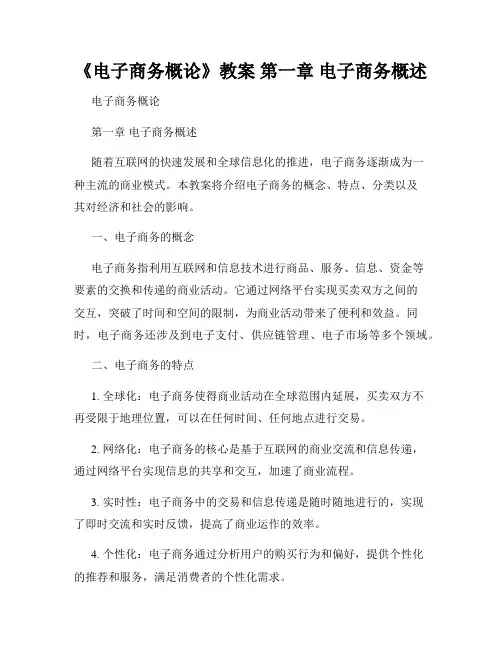
《电子商务概论》教案第一章电子商务概述电子商务概论第一章电子商务概述随着互联网的快速发展和全球信息化的推进,电子商务逐渐成为一种主流的商业模式。
本教案将介绍电子商务的概念、特点、分类以及其对经济和社会的影响。
一、电子商务的概念电子商务指利用互联网和信息技术进行商品、服务、信息、资金等要素的交换和传递的商业活动。
它通过网络平台实现买卖双方之间的交互,突破了时间和空间的限制,为商业活动带来了便利和效益。
同时,电子商务还涉及到电子支付、供应链管理、电子市场等多个领域。
二、电子商务的特点1. 全球化:电子商务使得商业活动在全球范围内延展,买卖双方不再受限于地理位置,可以在任何时间、任何地点进行交易。
2. 网络化:电子商务的核心是基于互联网的商业交流和信息传递,通过网络平台实现信息的共享和交互,加速了商业流程。
3. 实时性:电子商务中的交易和信息传递是随时随地进行的,实现了即时交流和实时反馈,提高了商业运作的效率。
4. 个性化:电子商务通过分析用户的购买行为和偏好,提供个性化的推荐和服务,满足消费者的个性化需求。
5. 交互性:电子商务通过网络平台实现买卖双方的直接交流和互动,消除了传统商务中的中间环节,加强了买卖双方之间的联系。
三、电子商务的分类根据业务范围和交易主体的不同,电子商务可分为以下几类:1. B2C电子商务(Business-to-Consumer):指企业与个人之间的电子商务活动,如电商平台上的网店直接向个人消费者销售商品。
2. B2B电子商务(Business-to-Business):指企业与企业之间的电子商务活动,如供应链管理、企业间的在线合作等。
3. C2C电子商务(Consumer-to-Consumer):指个人与个人之间的电子商务活动,如二手交易平台、在线拍卖等。
4. C2B电子商务(Consumer-to-Business):指个人向企业提供产品或服务的电子商务活动,如自由职业者通过网上平台接受企业的项目委托。
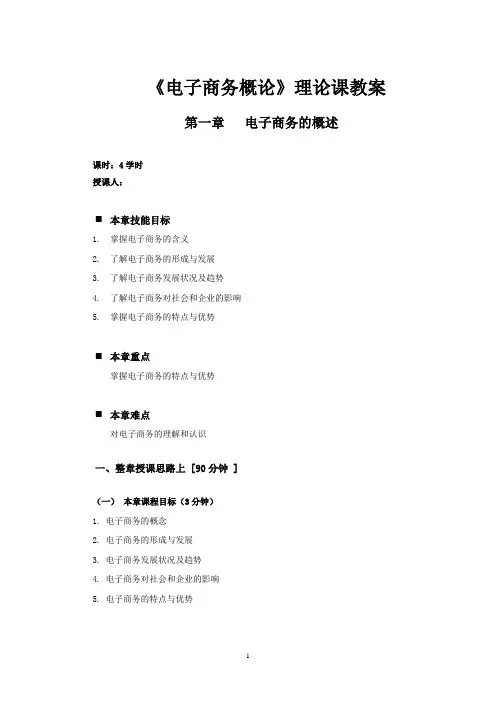
《电子商务概论》理论课教案第一章电子商务的概述课时:4学时授课人:⏹本章技能目标1.掌握电子商务的含义2.了解电子商务的形成与发展3.了解电子商务发展状况及趋势4.了解电子商务对社会和企业的影响5.掌握电子商务的特点与优势⏹本章重点掌握电子商务的特点与优势⏹本章难点对电子商务的理解和认识一、整章授课思路上 [90分钟 ](一)本章课程目标(3分钟)1. 电子商务的概念2. 电子商务的形成与发展3. 电子商务发展状况及趋势4. 电子商务对社会和企业的影响5. 电子商务的特点与优势(二)上课之前跟同学讨论的3个问题?(6分钟)1.大家一般上网做些什么?2.大家听说过电子商务吗?3.大家如何理解电子商务?(三)日常中的电子商务案例PPT P6-10(6分钟)淘宝京东去哪儿订购机票当当订购书籍手机APP饿了吗订餐电子商务改变了企业的经营管理模式以及改变了政府的形象。
一位白领说:“自公司用移动电子商务以来,处理问题更加的高效,有问题可以及时与客户沟通,同时能了解到最新的商机。
”政府公务员说:“自实施电子政务以来,政府部门的工作效率得到很大的提升,方便快捷。
”通过以上案例引出电子商务的含义,让学生更深入的理解其定义。
(四)电子商务的概述(16分钟)重点讲解,PPT 12-171. 电子商务的含义-重点电子商务(Electronic Commerce / EC)是指利用计算机、网络技术和远程通信进行的商贸活动和交易,实现消费者的网上购物、商户之间的网上交易和在线电子支付以及各种商务活动、交易活动、金融活动和相关的综合服务活动的一种新型的商业运营模式。
我们简单的定义为:电子商务就是指系统化地利用电子工具,高效率、低成本地从事以商品交换为中心的各种活动的全过程。
2.电子商务包含哪2个方面-重点(1)电子商务包含两个方面,一是电子方式,二是商贸活动。
(2)他们之间的关系:商务是核心,电子是手段和工具。
(3)商务与电子的关系图讲解,PPT13页。
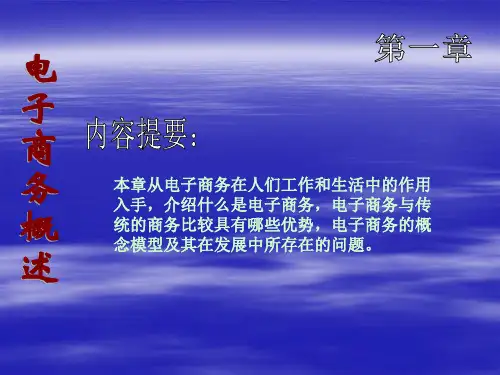
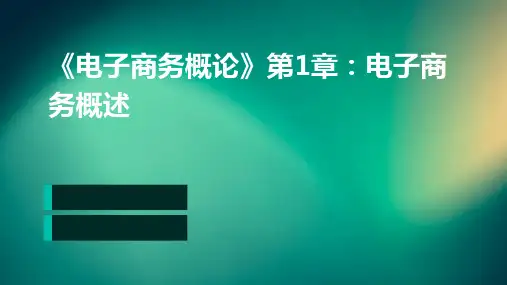
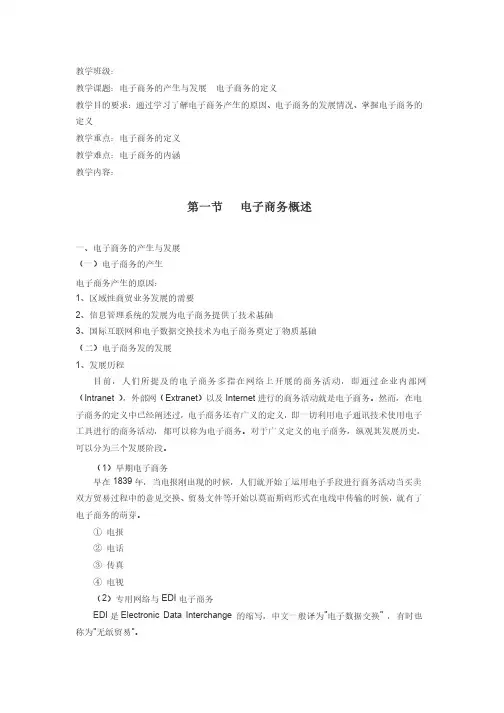
教学班级:教学课题:电子商务的产生与发展电子商务的定义教学目的要求:通过学习了解电子商务产生的原因、电子商务的发展情况、掌握电子商务的定义教学重点:电子商务的定义教学难点:电子商务的内涵教学内容:第一节电子商务概述一、电子商务的产生与发展(一)电子商务的产生电子商务产生的原因:1、区域性商贸业务发展的需要2、信息管理系统的发展为电子商务提供了技术基础3、国际互联网和电子数据交换技术为电子商务奠定了物质基础(二)电子商务发的发展1、发展历程目前,人们所提及的电子商务多指在网络上开展的商务活动,即通过企业内部网(Intranet ),外部网(Extranet)以及Internet进行的商务活动就是电子商务。
然而,在电子商务的定义中已经阐述过,电子商务还有广义的定义,即一切利用电子通讯技术使用电子工具进行的商务活动,都可以称为电子商务。
对于广义定义的电子商务,纵观其发展历史,可以分为三个发展阶段。
(1)早期电子商务早在1839年,当电报刚出现的时候,人们就开始了运用电子手段进行商务活动当买卖双方贸易过程中的意见交换、贸易文件等开始以莫而斯码形式在电线中传输的时候,就有了电子商务的萌芽。
①电报②电话③传真④电视(2)专用网络与EDI电子商务EDI是Electronic Data Interchange 的缩写,中文一般译为"电子数据交换" ,有时也称为"无纸贸易"。
①20世纪70年代——EDI技术的开发。
②70年代末和80年代——兴起“无纸贸易”热潮。
(3)Internet的电子商务发展20世纪90年代,Internet是一个连接无数个、遍及全球范围的广域网和局域网的互联网络。
Internet网的兴起将分布于世界各地的信息网络、网络站点、数据资源和用户有机地联为一个整体,在全球范围内实现了信息资源共享、通信方便快捷,因而它已经成为目前人们工作、学习、休闲、娱乐,相互交流以及从事商业活动的主要工具。
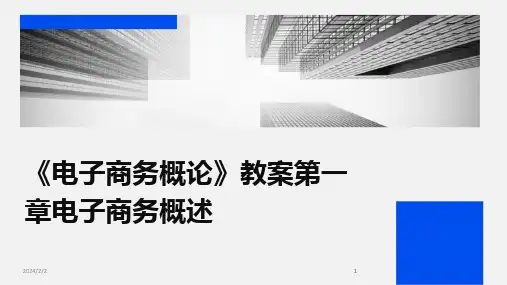
章电子商务概述•电子商务基本概念与定义•电子商务分类与应用领域•电子商务技术基础与架构•电子商务市场分析与竞争格局目•电子商务法律法规与伦理道德问题探讨•电子商务创新实践与未来展望录电子商务定义及特点电子商务定义电子商务是利用计算机技术、网络技术和远程通信技术,实现整个商务过程中的电子化、数字化和网络化。
电子商务特点包括全球性、即时性、直接性、无纸化交易、顾客导向等。
电子商务发展历程与趋势电子商务发展历程起步期、雏形期、发展期、成熟期。
电子商务发展趋势移动化、社交化、云计算化、大数据化、人工智能化等。
电子商务打破了传统商业模式中的时间、地域限制,实现了全天候、全球化的交易。
改变传统商业模式促进企业转型升级引领消费模式变革电子商务推动了企业信息化、网络化的进程,促进了企业业务流程的优化和重组。
电子商务为消费者提供了更加便捷、个性化的购物体验,引领了消费模式的变革。
030201电子商务对传统商业模式影响B2B (Business-to-Business )电子商务模式主要涉及企业之间的交易,包括产品、服务和信息的交换。
企业间交易通过B2B 电子商务模式,企业可以更有效地管理供应链,与供应商、分销商和合作伙伴实现信息共享和协同工作。
供应链管理企业可以利用B2B 电子商务平台进行采购和招投标活动,降低采购成本,提高采购效率。
采购与招投标在线零售B2C 电子商务模式广泛应用于在线零售行业,消费者可以通过电子商务平台购买各种商品。
面向消费者的销售B2C (Business-to-Consumer )电子商务模式是指企业直接向最终用户销售产品或服务的商业模式。
个性化服务B2C 电子商务模式还可以提供个性化服务,如定制产品、在线咨询等,满足消费者的个性化需求。
个人之间的交易C2C(Consumer-to-Consumer)电子商务模式是指个人之间通过互联网进行交易的模式。
二手商品交易C2C电子商务模式在二手商品交易领域具有广泛应用,消费者可以在平台上出售或购买二手商品。
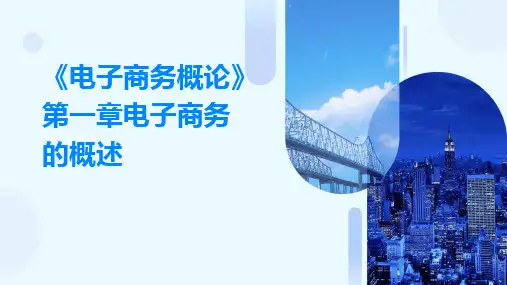
的概述contents •电子商务基本概念与特点•电子商务技术基础与应用•电子商务市场分析与趋势预测•电子商务法律法规与政策支持•电子商务对传统产业变革影响•总结:未来电子商务发展展望与挑战目录电子商务基本概念与特点01CATALOGUE电子商务定义及发展历程电子商务定义电子商务(Electronic Commerce,简称EC)是指利用计算机、网络和电子通信技术等现代信息技术手段所进行的各类商务活动。
发展历程电子商务经历了从电子数据交换(EDI)到基于互联网的电子商务的发展过程,随着互联网技术的不断发展和普及,电子商务逐渐成为一种全球性的商业活动。
电子商务主要类型与模式主要类型根据交易对象的不同,电子商务可分为B2B(Business-to-Business,企业对企业)、B2C(Business-to-Consumer,企业对消费者)、C2C(Consumer-to-Consumer,消费者对消费者)等类型。
主要模式电子商务模式包括电子市场、电子采购、电子销售、电子拍卖、虚拟社区等。
降低交易成本通过电子化手段进行商务活动,可以减少传统商务活动中的人力、物力和时间成本。
提高交易效率电子商务可以实现全天候、全球化的交易,提高交易效率。
拓展市场范围通过电子商务平台,企业可以突破地域限制,拓展全球市场。
增强企业竞争力电子商务可以帮助企业实现业务流程的优化和重组,提高企业的竞争力。
安全问题由于互联网的开放性和匿名性,电子商务交易存在安全隐患,如信息泄露、网络攻击等。
法律问题电子商务涉及到合同、税收、知识产权等法律问题,目前相关法律法规尚不完善。
技术问题虽然互联网技术已经相当成熟,但在一些偏远地区或发展中国家,网络覆盖率和网络质量仍然较低,限制了电子商务的发展。
电子商务技术基础与应用02CATALOGUE了解互联网的定义、发展历程、基本构成和功能。
互联网基本概念互联网协议与技术网络安全与防护掌握TCP/IP 协议、HTTP 协议、SMTP 协议等互联网基础协议,以及HTML 、CSS 、JavaScript 等前端技术。
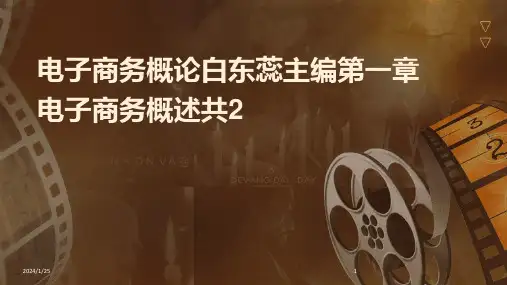
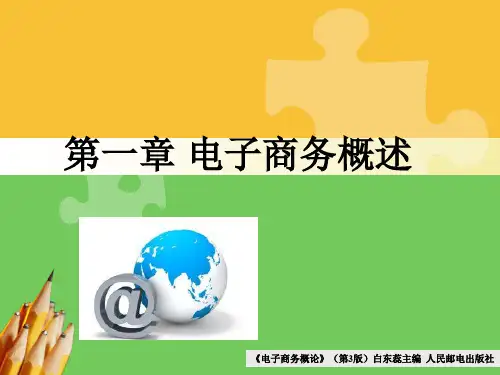

电子商务概论复习重点第一章电子商务概述一.电子商务的概念:①狭义的定义:以现代互联网为依托进行的商品和服务的交换.(EC)②广义的定义:利用现代化的先进信息技术和通信手段,以互联网为依托进行的一切商务活动的总和。
(EB)【包括企业内部、企业与企业、企业与消费者、消费者与消费者之间等所有商务电子化的过程】二.电商相对传统商务优势在何处?1.节约社会劳动和经济资源2.突破时空限制,弱化地理限制,合理配置社会资源3。
节省时间,提高效率4. 全球市场,庞大消费者群(全球性)5.高度自主、自由的市场环境(商务性)三.企业为什么/如何实施电商?(开放题)1. 电子商务影响内外部管理运作高效、低成本◆企业内部信息化◆企业间联系电子化◆企业与消费者联系电子化◆企业业务转型业务增多(传统和虚拟)新的贸易组合2. 电子商务带来第四利润源利润源◆降低物质消耗◆提高劳动效率\节约劳动消耗◆流通领域中节约流通费用◆第四利润源生产经营中通过降低信息成本,充分有效利用信息而增利。
第二章电子商务模式一.按参与者的不同其模式有哪些1。
企业对企业(B2B)2.企业对消费者(B2C)3。
企业对政府(B2G)4。
消费者对消费者(C2C)5。
消费者对政府(C2G)6。
政府对政府(G2G)二.举出B2B、B2C、C2C电子商务模式企业例子B2B:阿里巴巴、环球资源网、中国制造网、网盛生意宝、慧聪网B2C:当当网、亚马逊中国、京东商城、凡客诚品、携程、同程C2C: eBay、易趣网、天猫、威客中国、换客中国、人人网三.能够对给出企业做详细分析1.因特网提供的服务有哪些?P50-512.Internet的通信协议Telnet:网络终端协议,负责用户远程登录服务FTP:文件传输协议,负责网络中主机间的文件拷贝传送SMTP:简单邮件传输协议,负责电子邮件的传送DNS:域名解析服务协议,负责域名到IP地址之间的转换HTTP:超文本传输协议,用于客户机与WWW服务器间的数据传输。
Chapter 1 Overview of Electronic Commerce1.1 True/False2) Electronic exchange is the process of buying, selling, or exchanging products, services, or information via computer. Answer: FALSE4) The form EC takes depends on the degree of digitization of the product sold, the process, and the delivery method.Answer: TRUE6) The terms e-commerce and e-business can be used interchangeably.Answer: TRUE8) Pure-play organizations are old-economy organizations that perform their primary business offline, selling physical products by means of physical agents.Answer: FALSE10) Online publishing is an electronic commerce application. Answer: TRUE12) Every company needs a business model describing how the company operates, how it generates sales, and how it provides value to the customers and eventually profit to its owners. Answer: TRUE14) In order for a situation to be considered as electronic commerce, the product, process, and delivery method should all be digital.Answer: FALSE16) Collaborative computing is an approach aimed at making the human-computer interface more natural.Answer: FALSE18) Enterprise social networks are privately owned by corporations and operate inside them.Answer: TRUE20) Digital economy refers to an economy based on digital communication networks, computers, software, and other related information technologies that provide a global platform over which people and organizations interact, communicate, collaborate, and search for information.Answer: TRUE22) Economic, legal, societal, and technological factors have created a highly competitive business environment in which customers are becoming less powerful.Answer: FALSE24) Business models are a subset of a business plan or business case and refer to methods of doing business by which a company can generate revenue.Answer: TRUE1.2 Multiple Choice2) The type of EC transactions used by Zappos areA) business-to-business.B) business-to-business-to-consumer.C) business-to-consumer.D) consumer-to-business.Answer: C4) A broader definition of EC that includes not just the buying and selling of goods and services, but also servicing customers, collaborating with business partners, and conducting electronic transactions within an organization best definesA) e-business.B) e-tailing.C) e-collaboration.D) cyber business.Answer: A6) Old-economy organizations that perform their primary business offline, selling physical products by means of physical agents best definesA) click-and-mortar organizations.B) pure-play organizations.C) classic commerce organizations.D) brick-and-mortar organizations.Answer: D8) EC can take several forms depending on the degree of digitization of the following three dimensions:A) the product or service sold, the process, and the delivery method.B) the business process, the collaboration, and the transaction.C) the payment method, the delivery method, and the production method.D) the marketing channel, the agent, and the collaborationmethod.Answer: A10) Support areas for EC include each of the following exceptA) infrastructure.B) people.C) public policy.D) business partnerships.Answer: A12) The e-commerce model in which a business provides some product or service to a client business that maintains its own customers is calledA) business-to-consumer.B) business-to-business.C) business-to-business-to-consumer.D) consumer-to-consumer.Answer: C14) Ebay auctions are mostlyA) business-to-employees.B) consumer-to-business.C) business-to-consumer.D) consumer-to-consumer.Answer: D16) A category of Internet applications that helps connect friends, business partners, or individuals with specific interests by providing free services such as photo presentation, e-mail, blogging, and so on using a variety of tools best describesA) social networking.B) public networking.C) intranet.D) extranet.Answer: A18) Using Web 2.0 tools, companies canA) encourage consumers to rate and comment on products.B) allow consumers to create their own topic areas and build communities.C) provide incentives such as sweepstakes and contests forcustomers to get involved in new product or service design and marketing campaigns.D) do all of the above.Answer: D20) Which of the following is not a major revenue model?A) attributive feeB) salesC) transaction feesD) subscription feesAnswer: A22) A ________ is a company's method of doing business to generate revenue to sustain itself.A) marketing strategyB) business modelC) value chainD) business planAnswer: B24) According to the ________ revenue model, companies receive commissions for referring customers to others' EC Web sites.A) advertising feesB) subscription feesC) affiliate feesD) transaction feesAnswer: C26) Large private organizational buyers and government agencies make large-volume or large-value purchases through ________, also known as reverse auctions.A) electronic tendering systemsB) online direct marketingC) name-your-own-price modelsD) viral marketingAnswer: A28) Benefits of e-commerce to customers includeA) ubiquity.B) instant delivery.C) no sales tax.D) all of the above.Answer: D30) Major barriers to EC include all of the following exceptA) cost.B) lack of potential customers.C) implementation difficulties.D) lack of programmers.Answer: D1.3 Fill in the Blank1) ________ is the process of buying, selling, transferring, or exchanging products, services, and/or information via computer. Answer: Electronic commerce2) ________ is a broader definition of EC that includes not just the buying and selling of goods and services, but also servicing customers, collaborating with business partners, and conducting electronic transactions within an organization. Answer: E-business3) ________ refers to old-economy organizations or corporationsthat perform their primary business offline, selling physical products by means of physical agents.Answer: Brick-and-mortar organization4) ________ are organizations that conduct their business activities solely online.Answer: Virtual organizations5) ________ are organizations that conduct some e-commerce activities, usually as an additional marketing channel. Answer: Click-and-mortar organizations6) An ________ is an internal corporate or government network that uses Internet tools such as Web browsers and Internet protocols.Answer: intranet7) An ________ is a network that uses the Internet to link multiple intranets.Answer: extranet8) The e-commerce model in which a business provides some product or service to a client business that maintains its own customers is called ________.Answer: business-to-business-to-consumer9) ________ describes the hardware, software, and networks used in EC.Answer: Infrastructure10) The e-commerce model in which individuals use the Internetto sell products or services to organizations or individuals who seek sellers to bid on products or services they need is called ________.Answer: consumer-to-business11) The e-commerce category that includes all internal organizational activities that involve the exchange of goods, services, or information among various units and individuals in an organization is ________.Answer: intrabusiness EC12) The e-commerce model in which an organization delivers services, information, or products to its individual employees is ________.Answer: business-to-employees13) ________ is the e-commerce model in which consumers sell directly to other consumers.Answer: Consumer-to-consumer21) A method of doing business by which a company can generate revenue to sustain itself defines ________. Answer: business model11Copyright © 2011 Pearson Education, Inc. Publishing as Prentice Hall。